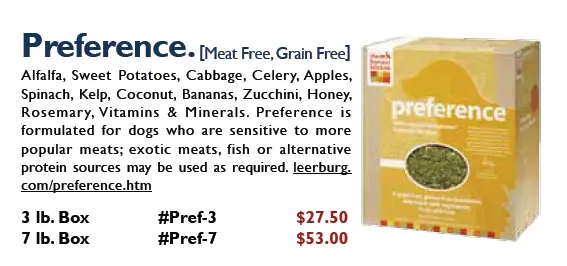
This is a placeholder text
Group text
by daisy304 on 27 September 2011 - 18:09
by Two Moons on 27 September 2011 - 19:09
there is nothing wrong with adding any kind of meat to your dogs diet, or fat.
Watch for small bones and do not cross contaminate your own food supply when dealing with meats such as chicken.
Same goes for eggs, makes for a nice coat, I use canned salmon as well, and often cheese to supplement my kibble.
I do not feed exclusively raw.
Just avoid things that are not necessary, keep it simple.
Moons.
P.S.
I see no benifit in feeding a dog chicken feet.
by isachev on 27 September 2011 - 22:09
to help you. Take Care Pete
http://www.saveourshepherds.org/raw.html
http://preymodelraw.com/
http://preymodelraw.com/how-to-get-started/
by Pharaoh on 28 September 2011 - 00:09
Daisy, see if you can get chicken backs or chicken frames. Lots of good organs attached.
Michele
by SitasMom on 28 September 2011 - 19:09

you could add this to raw meat to obtain a balanced diet.......
by lzaichenko on 28 September 2011 - 21:09
Chicken feet are great at providing a dose of glucosamine and chondroitin to the diet.
To the OP: I encourage you to join the rawfeeding Yahoo! group and search the archives as well as ask any questions you may have. Chicken feet and necks are high in bone content. I feed both to my dogs, but I also feed much more boneless muscle meat. Bones help firm the stool, organ meat and boneless meat makes it a bit looser. The balance that we try to maintain is 80% "meaty meat", 10% bone and 10% organ (5% of which is liver). This is a recipe of "balance over time," not per daily meal. So in a week my dogs eat a variety of things like heart (muscle), tripe (muscle), turkey necks (bone/muscle), liver, kidney , lung (organs, although the lung is debatable). I feed whatever other meat I can get my hands on for a reasonable price as well; pork, beef, chicken, etc. The ideal is to have as much red meat as possible.
http://pets.groups.yahoo.com/group/rawfeeding/
http://pets.groups.yahoo.com/group/RawChat/
by daisy304 on 29 September 2011 - 12:09
by HighDesertGSD on 29 September 2011 - 23:09
Plant matters are completely normal for carnivores. The more alpha the animal the more plant matters it will ingest. The most alpha generally eat the gut contents of prey animals that have a lot of plant matters. When the belly is ripped open the alpha animal eats first.
Some think some plant matters may be good for carnivores.
by lzaichenko on 30 September 2011 - 16:09
Some think some plant matters may be good for carnivores."
What did you base this opinion off of? Yes, the abdominal cavity is torn open and its contents are consumed. But this includes the organs -- liver, spleen, kidneys, lungs, heart, stomach -- but not the contents of the stomach.
http://rawfed.com/myths/stomachcontents.html
The following quote is from L. David Mech's 2003 book Wolves: Behavior, Ecology, and Conservation. Mech (and the others who contributed to this book) is considered the world's leading wolf biologist, and this book is a compilation of 350 collective years of research, experiments, and careful field observations. These quotes are taken from chapter 4, The Wolf as a Carnivore.
"Wolves usually tear into the body cavity of large prey and...consume the larger internal organs, such as lungs, heart, and liver. The large rumen [, which is one of the main stomach chambers in large ruminant herbivores,]...is usually punctured during removal and its contents spilled. The vegetation in the intestinal tract is of no interest to the wolves, but the stomach lining and intestinal wall are consumed, and their contents further strewn about the kill site." (pg.123, emphasis added)
"To grow and maintain their own bodies, wolves need to ingest all the major parts of their herbivorous prey, except the plants in the digestive system." (pg.124, emphasis added).
This next quote can be found on the Hunting and Meals page at Kerwood Wildlife Education Center.
"The wolf's diet consists mostly of muscle meat and fatty tissue from various animals. Heart, lung, liver, and other internal organs are eaten. Bones are crushed to get at the marrow, and bone fragments are eaten as well. Even hair and skin are sometimes consumed. The only part consistently ignored is the stomach and its contents. Although some vegetable matter is taken separately, particularly berries, Canis lupus doesn't seem to digest them very well."
by HighDesertGSD on 30 September 2011 - 17:09
I find it hard to believe that wolves have so much time to remove any vegetation before consumption.
Feeding is very competitive.
Some vegetation will be ingested, IMO.
Contact information Disclaimer Privacy Statement Copyright Information Terms of Service Cookie policy ↑ Back to top




